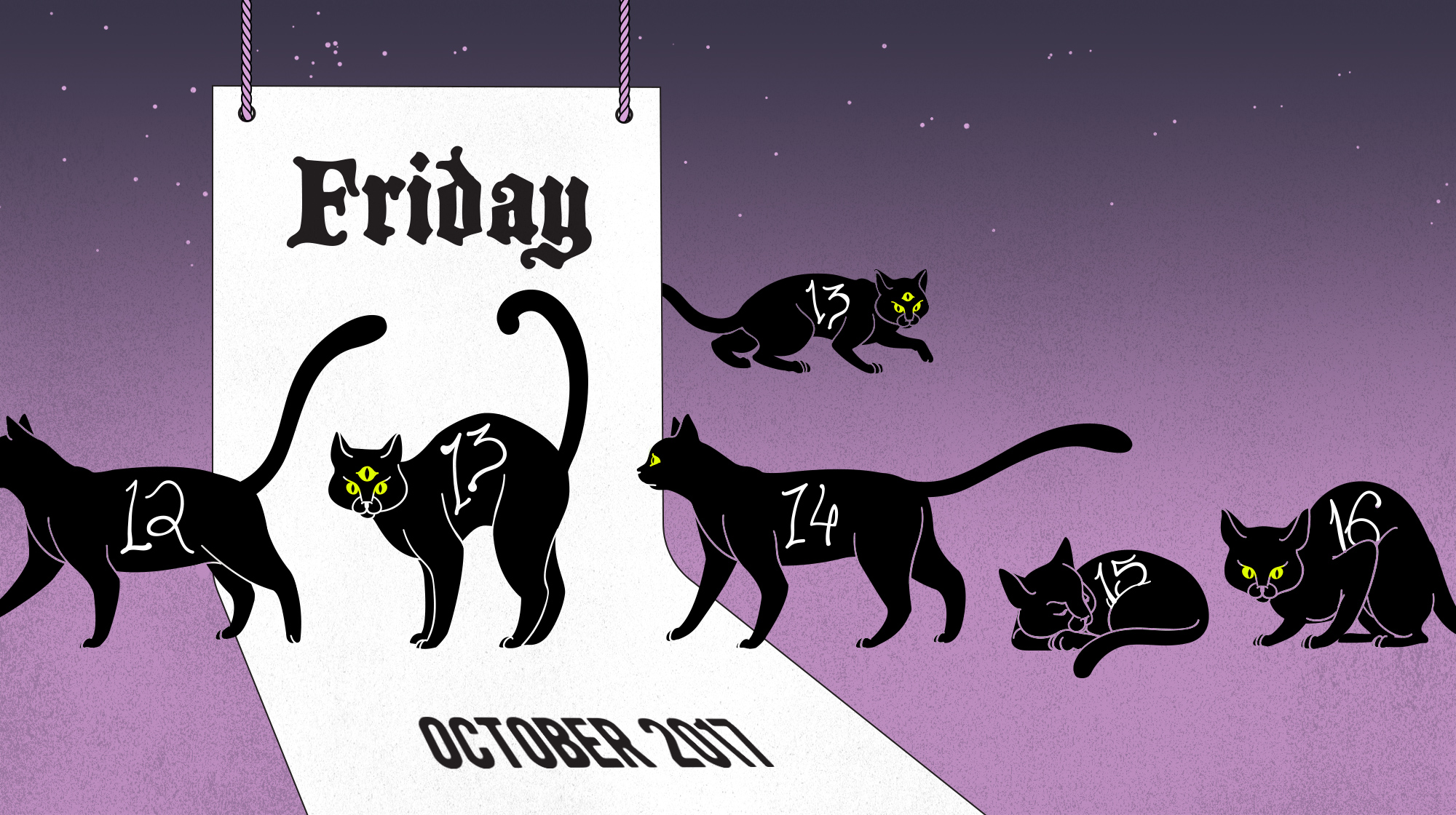Is It Friday the 13th Again?

Olena Shmahalo/Quanta Magazine
Introduction
In some of our recent Insights puzzles, we’ve tackled questions related to time: How much time does it take for a gene’s rate of evolution to slow to a virtual standstill? How many half-lives does a pound of radioactive material have? What can an LCD display teach us about time’s arrow? This month, let’s take a look at a different aspect of time — how we keep track of it.
Our subject is the calendar and that oft-repeated question when a specified date is mentioned: “What day of the week is that?” Sometimes, if the date isn’t too far into the future, we can figure it out in our heads, but often we need to check the calendar. Calendars, like culture and language, are unruly things that have arisen organically by happenstance. They try to balance many competing demands, such as astronomical compliance (“A year must have 365 days — well, except in leap years” or “A month should be as long as a lunar cycle — kind of”), social/religious conventions (“A week should have seven days”), historical accidents (“Why is the 10th month called October — shouldn’t that be the eighth month?”) and regional and religious identity (e.g., Chinese, Hebrew, Islamic and Hindu calendars, among others). Most calendars do have some elements of logic and order, but these are often afterthoughts. Every calendar has its version of “Are there 30 or 31 days in April?” And if you add the superstitious fear of Friday the 13th to the chaos, it gives us plenty of fodder for our puzzle today.
Question 1:
The year 2017 began with a Friday the 13th in January, and another one is due in October. What’s the maximum and minimum number of Friday the 13th’s that there can be in a Gregorian calendar year?
This question can, of course, be solved by brute force methods, but can you find an easy way to answer it that you could conceivably even do in your head?
Question 2:
Suppose that instead of being spooked by Friday the 13th, you consider it to be your lucky day, and you want to maximize the number of Friday the 13th’s in a year. You are allowed to tamper with the monthly distribution of days in a normal nonleap year in the following way: You can take away one day from any month of the year and add it from any other. For instance, you could, like Robin Hood, rob the day-rich December of one day, reducing it to 30 days, and bump up February’s quota to 29 days. Or you could, like a kleptocrat, decree that January has 32 days while poor February has just 27. What’s the maximum number of Friday the 13th’s you could create in this way in a single year? What if you could do the above procedure for two pairs of months, without using any month twice?
Question 3:
On the subject of days and dates, there is something special about the 12th of March, the 9th of May and the 11th of July that requires a global perspective to appreciate.
Each of these dates has a “twin” date with which it shares a special property. Can you figure out what it is? Note: There are some other pairs of twin dates (how many?) that have a similar property, but the three that are mentioned above (with their twin dates) possess it to a degree that is ahead of the others by leaps and bounds.
If nothing leaps out at you, here are a couple of hints. (Click on Hint 1 and Hint 2 to make them appear.)
Hint 1: To appreciate the relationship between the two dates that form a pair, you need to look at them from both sides of the pond.
Hint 2: Are there other ways to write a date than the one you are used to?
Such puzzles could not have existed if we had used top-down logic to reform our unruly calendars. There are many such proposals, all of which try to render obsolete the pesky question “What day of the week is that?’’ Such reformed calendars would not need to be printed every year just to let us know what day of the week a specific date falls on. One such suggestion involves having 13 months of 28 days each, with one or two additional extracalendar holidays that could be called something like “End-of-Year Day” or “Leap Day.” These days would be intercalary, or off-calendar, days. They would not be assigned to any month and would not be assigned a day of the week, either — they would be super-Sundays! With this scheme, you wouldn’t even need separate monthly calendars: You could just figure out the day of the week from the numerical date, no matter what month it is.
The above system is logical, but it suffers from one flaw: It has 13 months, and 13 is not just considered unlucky, but also isn’t divisible by four. This means that the division of the year into four quarters, or four seasons, of about three months each is not preserved. So let’s get creative. Can you think of a way that preserves weeks of 7 days, has months of about 30 days (let’s say 30 plus or minus no more than 5 days), preserves equal quarters and equal seasons, and does not need a new calendar every year? You can designate up to 7 days off-calendar holidays that do not have to belong to any month or week or both. It’s always nice to give yourself extra holidays!
In the spirit of dreaming up logical solutions that have no chance of being followed in the real world, let me tell you about my own suggestion for calendar reform. It concerns the base of the calendar — the 0th year from which we define the present year. Different calendars handle this differently, based in a parochial way on mythical or religiously significant events, such as the birth or enlightenment of a religious leader. Could we ever agree on a universal scientific justification to start counting years from a specific date when a particular intellectual realization emerged? Which idea would you choose? By my calendar, we are currently living in year 158 YI (Year of the Insight).
Readers are welcome to weigh in with alternative suggestions.
Editor’s note: The reader who submits the most interesting, creative or insightful solution (as judged by the columnist) in the comments section will receive a Quanta Magazine T-shirt. And if you’d like to suggest a favorite puzzle for a future Insights column, submit it as a comment below, clearly marked “NEW PUZZLE SUGGESTION” (it will not appear online, so solutions to the puzzle above should be submitted separately).
Note that we may hold comments for the first day or two to allow for independent contributions by readers.
Update: The solution has been published here.



